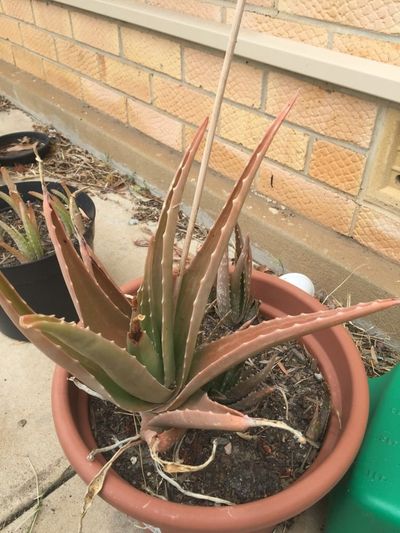Reasons for Wilting, Brown Aloe Plants
Aloe plants feature chubby, cherubic leaves that are also a helpful medicinal. The plants tend to like to be a bit on the dry side and most problems are caused by overwatering or incorrect potting medium. Brown aloe vera plants may be suffering from too much or too little moisture, but other causes might be excess salt in soil, fungal disease, sun scorch, chemical toxicity, or nutrient deficiency. Guessing which is simply a matter of trial and error.
Moisture and Aloe Wilting and Browning
Water issues have got to be the number one cause of problems with aloe vera. A wilting, brown aloe that has soft spots in the leaves is likely over watered. A plant with puckered leaves that are discoloring may be too dry. The leaves are a great indicator of the moisture needs of this plant. They should be plump and glossy green. To correct any water issues, repot the plant in a well-draining soil that is at least half gritty material such as sand or pumice. Once the plant is out of soil, check the roots for any rot and remove. Water only when the soil is dry to the touch when you insert a finger to the second knuckle. In winter, reduce water by half.
Chemicals, Salts and Nutrition
If you fertilize your plant, the soil may have excess salt buildup, which can burn roots and cause brown aloe vera plants. Leach the soil with plenty of water or repot the plant. When an aloe is turning brown, it might also be chemical exposure. Outdoor plants may receive herbicide drift from wind. Plants indoors may be splashed with cleaning chemicals. Treating wilting aloe veras that have chemical damage requires removal of the leaves if there are only a few and transplant to prevent any chemicals in soil from transporting into the vascular system of the plant. Aloe plants do not need much feeding. Feed no more than once per month with a diluted plant food at half strength.
Light and Cold
Most varieties of aloe prefer warm temperatures. Those that are exposed to drafty windows may develop some foliar damage. Move plants to a warmer location. Aloes prefer temperatures of 55 to 85 degrees F. (13-27 C.). These easy-to-grow plants also prefer quite a bit of light, however, when placed in a southern location by a window that directs heat and light to the plant, the leaves can actually sunburn. Bright, but indirect light is preferred. Sun scorched plants will recover over time naturally but may lose a few leaves in the process. Aloe wilting and browning is generally a matter of a cultural or site condition. Just go down the list and eliminate possible causes until you strike the right one. Aloe plants are very resilient and forgiving and should return to health again quite quickly.
